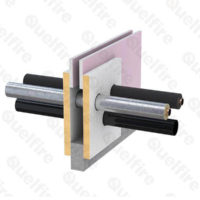
In this short article, we look at what passive fire protection is and what it covers, the use of the term ‘firestopping’, and the introduction of the term ‘service penetration seal’.
The term passive fire protection refers to a set of systems and measures that are designed to limit the spread of fire, smoke, and the amount of damage caused by fire in a building. Passive fire protection systems are built into the structure of a building and are intended to contain fires and prevent them from spreading to other parts of the building – known as compartmentation.
Although passive fire protection can be used to describe what we provide, it is an umbrella term that covers many different aspects of fire safety.
Passive fire protection measures include, but are not limited to:
- Intumescent fireproofing: This protects the structure of the building by using protective coatings on structural steel.
- Linear gaps and cavity barriers: Through sealing any imperfections of fit, this prevents fire or smoke from spreading via walls.
- Compartmentation: To contain the fire and smoke in one area, the building must be divided into areas of manageable risk using fire-rated walls and floors.
- Fire doors: Fire doors provide a clear means of escape by preventing the passage of fire and smoke into stairwells.
- Firestopping: This involves sealing around any pipes, ducts, or cables that pass through a compartment wall or floor.
Under the passive fire protection umbrella, firestopping (or fire stopping) is the term commonly used in the industry to describe our solutions. It has been around for decades and thus, some people may argue that it is quite outdated.
The history of firestopping
Passive fire protection measures, although not as prominent or advanced as today, have been around for centuries. For example, when the Great Fire of London destroyed the city in September 1666, the Act for the Rebuilding of the City of London was passed a year later in February 1667.
This was one of the earliest recordings of using fewer combustible materials to build: “It proposed that all new buildings had to be constructed of brick or stone against the future perils of fire. It also imposed a maximum number of storeys per house for a fixed number of abodes to eliminate overcrowding.”
However, the push for change to firestopping in buildings began in March 1975: the date of the Browns Ferry Nuclear Power Plant Disaster. At the time, polyurethane foam with a retardant material applied to the face was used to firestop the power plant’s service penetrations. Similar products still exist today, widely known as fire foam or ‘pink foam’. See also: What are the limitations of using PU fire foam?
Firestopping has become a prominent term used in the industry and although it can be used to describe what we provide, we feel that it is too generic a term and may be misleading for someone who is not familiar with fire safety.
We believe service penetration sealing to be the most accurate term because it is the most descriptive. It means to retain the fire rating of walls and floors by sealing service penetrations with the appropriate firestopping system tested for those particular applications.
Summary
- Passive fire protection is a broader term – it covers many areas of fire safety
- The term ‘firestopping’ has been around for decades
- Service penetration seal best describes what services we provide

This article was written by Darryl Wells
Commercial & Development Director
Learn More About Darryl Wells